Comprehensive Analysis of Business Finance: Cash Flow and Budgeting
VerifiedAdded on 2023/01/18
|39
|3219
|37
Report
AI Summary
This report provides a comprehensive analysis of business finance, encompassing key concepts such as profit, cash flow, working capital, receivables, payables, and inventory management. It explores the impact of fluctuations in working capital on cash flows, differentiating between positive and negative effects. The report then delves into the practical application of these financial aspects, using a case study of Bright Lawns to illustrate how concepts like accounts receivable, accounts payable, and inventory affect financial results. Furthermore, it offers recommendations for improving cash flow, including inventory valuation, expense control, and timely payments. The second part of the report examines the importance of budgets and different budgeting methods, contrasting traditional and alternative approaches like rolling budgets and zero-based budgeting. It discusses the implementation of budgets to forecast costs and analyzes the suitability of various budgetary systems for a business's future plans, providing a thorough overview of financial planning and analysis.
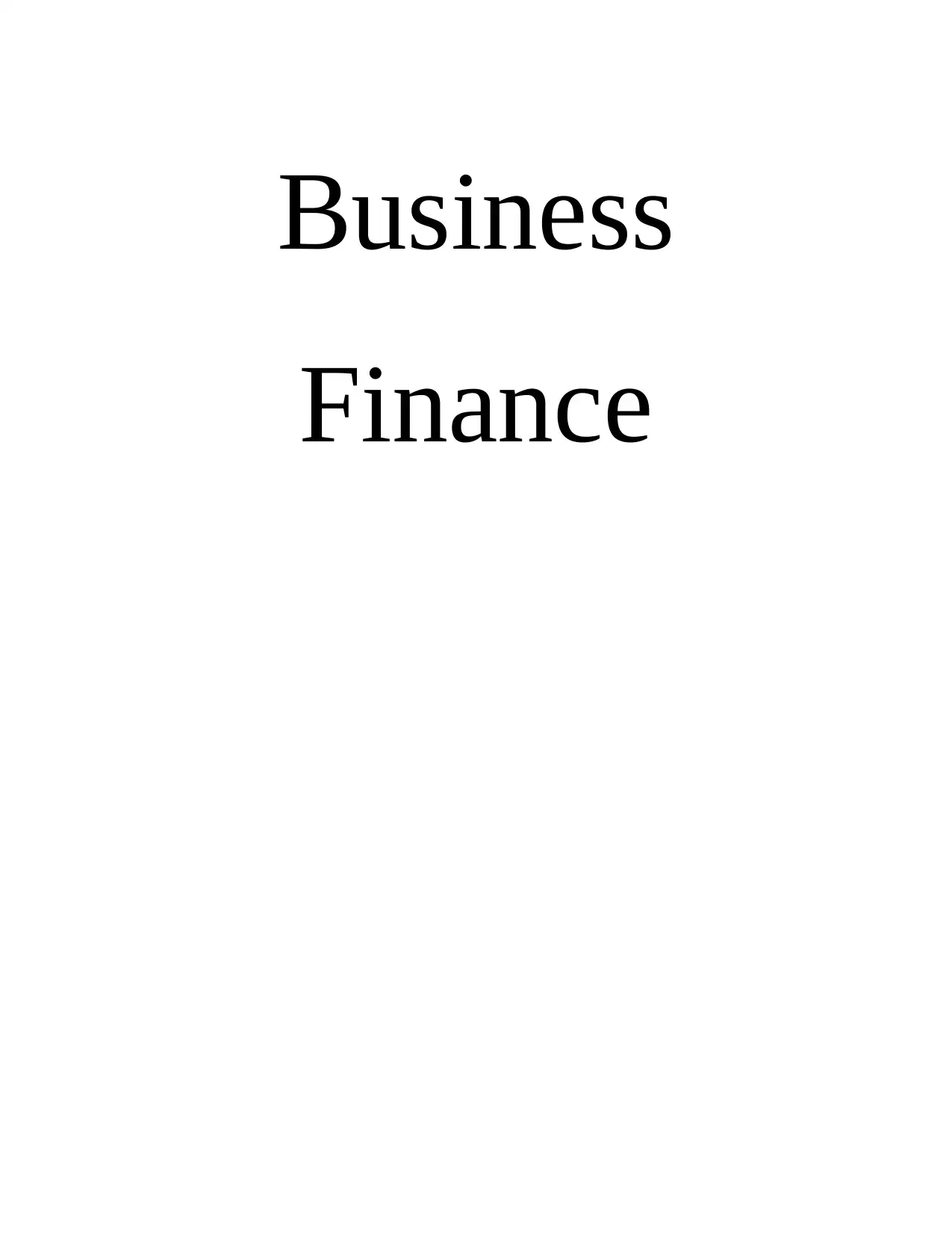
Business
Finance
Finance
Paraphrase This Document
Need a fresh take? Get an instant paraphrase of this document with our AI Paraphraser

Contents
Contents...........................................................................................................................................2
EXECUTIVE SUMMARY.............................................................................................................3
TASK...............................................................................................................................................4
Part 1............................................................................................................................................4
(I) Explanation of followings :....................................................................................................4
(ii) Concepts used to present the financial aspects to manage the impact of concepts upon
financial results............................................................................................................................6
iii) Analyse and recommendation about steps that are needed to be taken in order to improve
the cash flow................................................................................................................................6
PART 2............................................................................................................................................8
EXECUTIVE SUMMARY.............................................................................................................8
(I) Importance of budgets and different methods of traditional budgeting.................................8
(ii) Implementation of budgets to forecast cost for business.....................................................10
(iii) Analysing whether a traditional or alternative budgetary system is appropriate to all or any
parts of the business in its planned future form.........................................................................10
CONCLUSION..............................................................................................................................11
REFERENCES..............................................................................................................................12
Contents...........................................................................................................................................2
EXECUTIVE SUMMARY.............................................................................................................3
TASK...............................................................................................................................................4
Part 1............................................................................................................................................4
(I) Explanation of followings :....................................................................................................4
(ii) Concepts used to present the financial aspects to manage the impact of concepts upon
financial results............................................................................................................................6
iii) Analyse and recommendation about steps that are needed to be taken in order to improve
the cash flow................................................................................................................................6
PART 2............................................................................................................................................8
EXECUTIVE SUMMARY.............................................................................................................8
(I) Importance of budgets and different methods of traditional budgeting.................................8
(ii) Implementation of budgets to forecast cost for business.....................................................10
(iii) Analysing whether a traditional or alternative budgetary system is appropriate to all or any
parts of the business in its planned future form.........................................................................10
CONCLUSION..............................................................................................................................11
REFERENCES..............................................................................................................................12
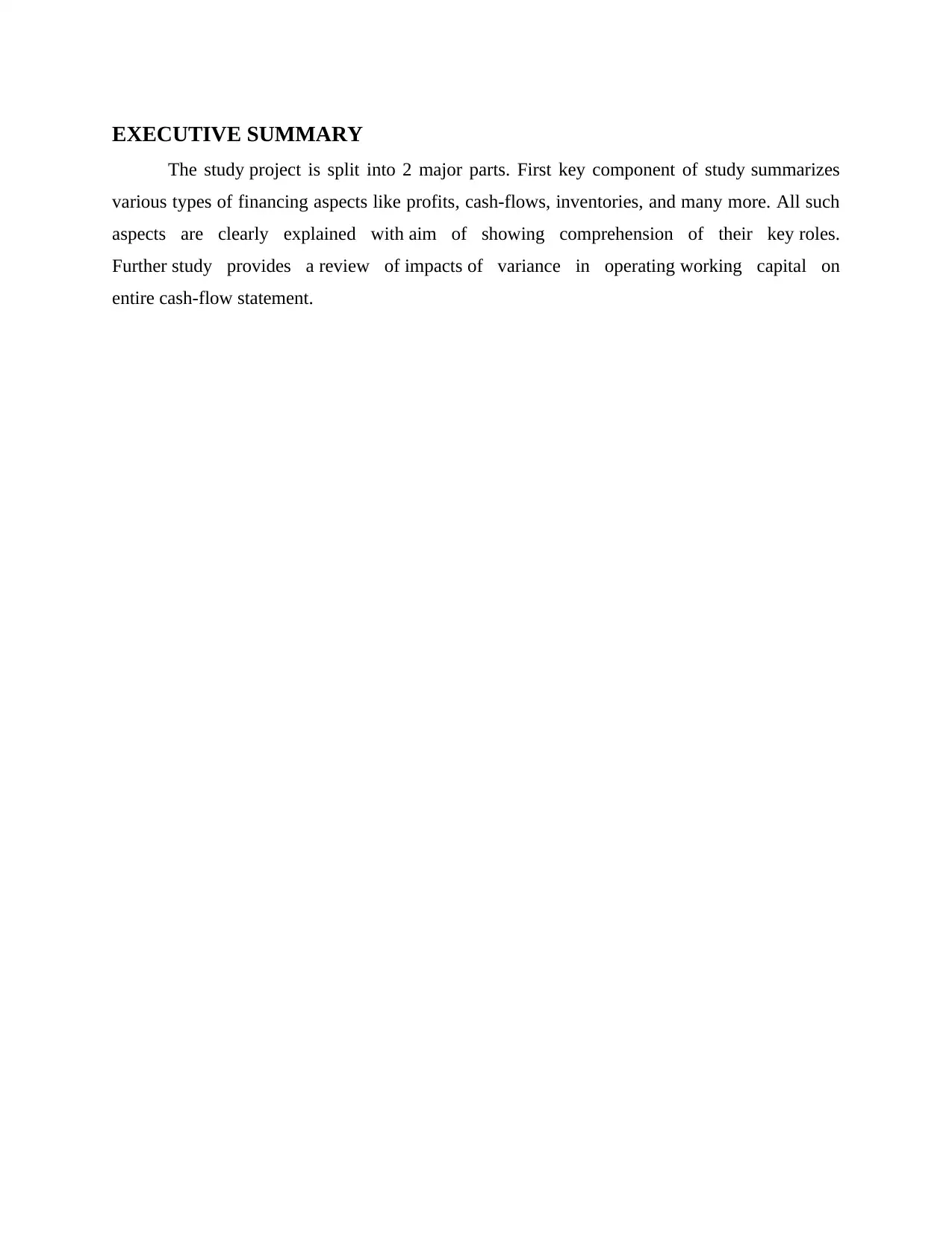
EXECUTIVE SUMMARY
The study project is split into 2 major parts. First key component of study summarizes
various types of financing aspects like profits, cash-flows, inventories, and many more. All such
aspects are clearly explained with aim of showing comprehension of their key roles.
Further study provides a review of impacts of variance in operating working capital on
entire cash-flow statement.
The study project is split into 2 major parts. First key component of study summarizes
various types of financing aspects like profits, cash-flows, inventories, and many more. All such
aspects are clearly explained with aim of showing comprehension of their key roles.
Further study provides a review of impacts of variance in operating working capital on
entire cash-flow statement.
⊘ This is a preview!⊘
Do you want full access?
Subscribe today to unlock all pages.

Trusted by 1+ million students worldwide
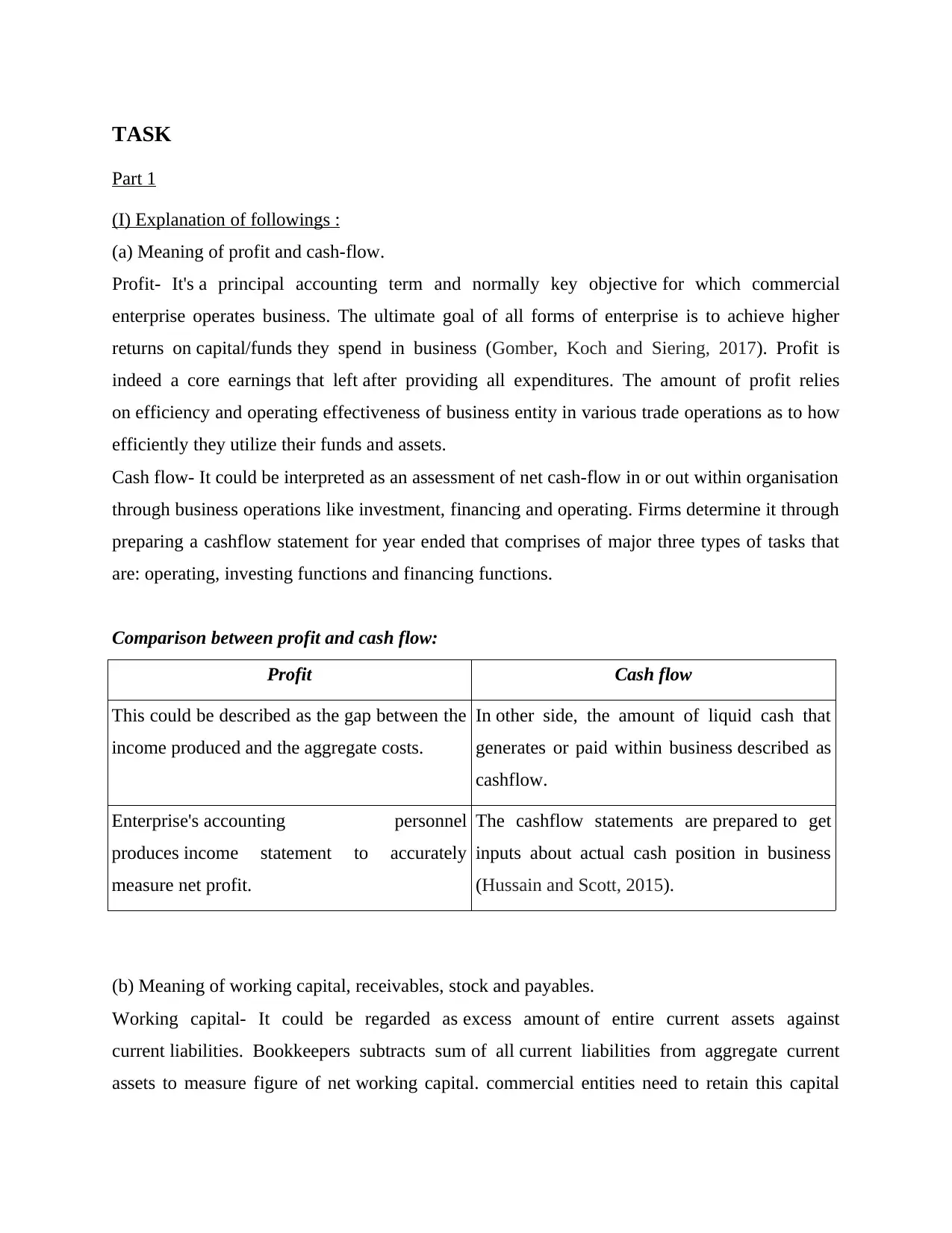
TASK
Part 1
(I) Explanation of followings :
(a) Meaning of profit and cash-flow.
Profit- It's a principal accounting term and normally key objective for which commercial
enterprise operates business. The ultimate goal of all forms of enterprise is to achieve higher
returns on capital/funds they spend in business (Gomber, Koch and Siering, 2017). Profit is
indeed a core earnings that left after providing all expenditures. The amount of profit relies
on efficiency and operating effectiveness of business entity in various trade operations as to how
efficiently they utilize their funds and assets.
Cash flow- It could be interpreted as an assessment of net cash-flow in or out within organisation
through business operations like investment, financing and operating. Firms determine it through
preparing a cashflow statement for year ended that comprises of major three types of tasks that
are: operating, investing functions and financing functions.
Comparison between profit and cash flow:
Profit Cash flow
This could be described as the gap between the
income produced and the aggregate costs.
In other side, the amount of liquid cash that
generates or paid within business described as
cashflow.
Enterprise's accounting personnel
produces income statement to accurately
measure net profit.
The cashflow statements are prepared to get
inputs about actual cash position in business
(Hussain and Scott, 2015).
(b) Meaning of working capital, receivables, stock and payables.
Working capital- It could be regarded as excess amount of entire current assets against
current liabilities. Bookkeepers subtracts sum of all current liabilities from aggregate current
assets to measure figure of net working capital. commercial entities need to retain this capital
Part 1
(I) Explanation of followings :
(a) Meaning of profit and cash-flow.
Profit- It's a principal accounting term and normally key objective for which commercial
enterprise operates business. The ultimate goal of all forms of enterprise is to achieve higher
returns on capital/funds they spend in business (Gomber, Koch and Siering, 2017). Profit is
indeed a core earnings that left after providing all expenditures. The amount of profit relies
on efficiency and operating effectiveness of business entity in various trade operations as to how
efficiently they utilize their funds and assets.
Cash flow- It could be interpreted as an assessment of net cash-flow in or out within organisation
through business operations like investment, financing and operating. Firms determine it through
preparing a cashflow statement for year ended that comprises of major three types of tasks that
are: operating, investing functions and financing functions.
Comparison between profit and cash flow:
Profit Cash flow
This could be described as the gap between the
income produced and the aggregate costs.
In other side, the amount of liquid cash that
generates or paid within business described as
cashflow.
Enterprise's accounting personnel
produces income statement to accurately
measure net profit.
The cashflow statements are prepared to get
inputs about actual cash position in business
(Hussain and Scott, 2015).
(b) Meaning of working capital, receivables, stock and payables.
Working capital- It could be regarded as excess amount of entire current assets against
current liabilities. Bookkeepers subtracts sum of all current liabilities from aggregate current
assets to measure figure of net working capital. commercial entities need to retain this capital
Paraphrase This Document
Need a fresh take? Get an instant paraphrase of this document with our AI Paraphraser
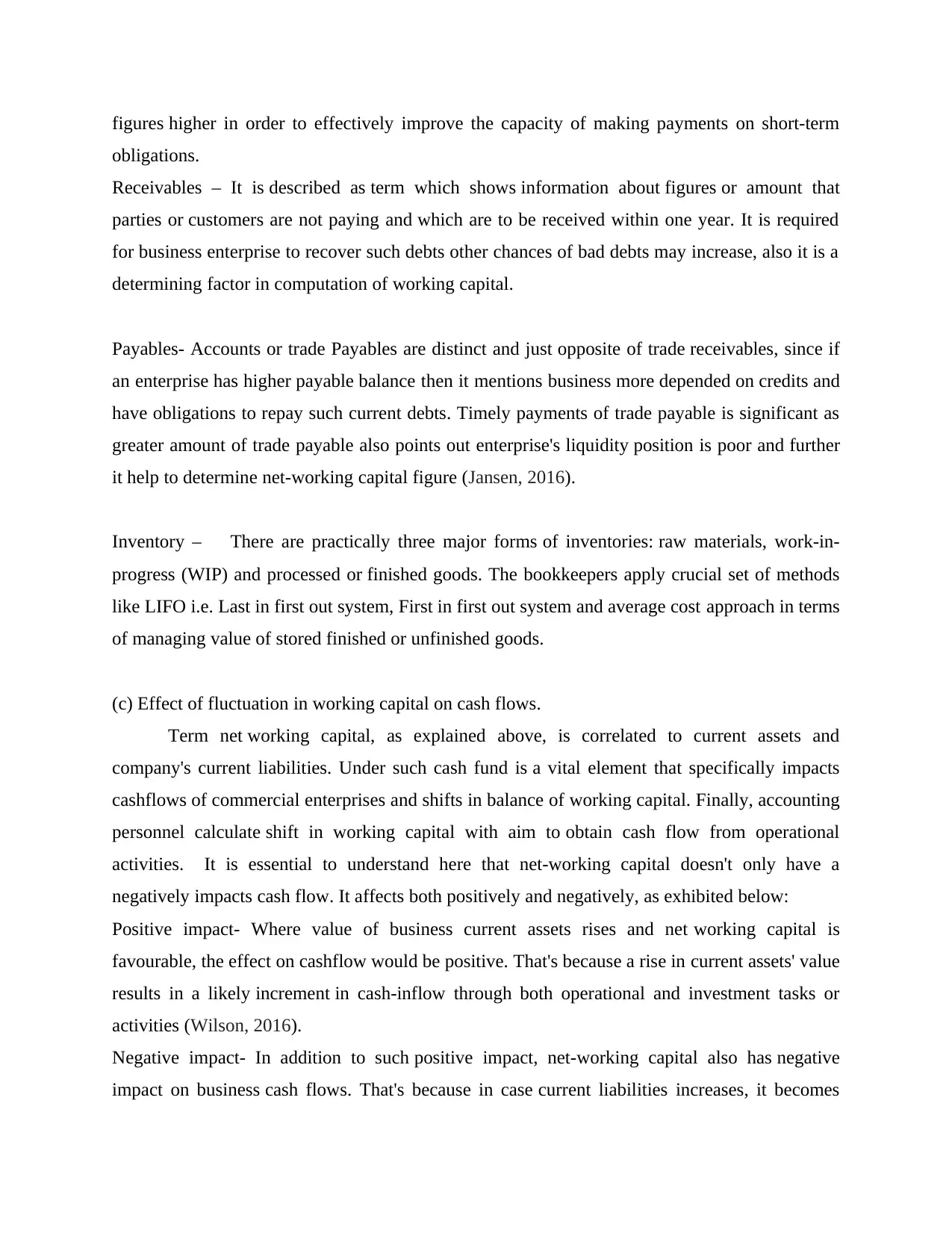
figures higher in order to effectively improve the capacity of making payments on short-term
obligations.
Receivables – It is described as term which shows information about figures or amount that
parties or customers are not paying and which are to be received within one year. It is required
for business enterprise to recover such debts other chances of bad debts may increase, also it is a
determining factor in computation of working capital.
Payables- Accounts or trade Payables are distinct and just opposite of trade receivables, since if
an enterprise has higher payable balance then it mentions business more depended on credits and
have obligations to repay such current debts. Timely payments of trade payable is significant as
greater amount of trade payable also points out enterprise's liquidity position is poor and further
it help to determine net-working capital figure (Jansen, 2016).
Inventory – ⠀ There are practically three major forms of inventories: raw materials, work-in-
progress (WIP) and processed or finished goods. The bookkeepers apply crucial set of methods
like LIFO i.e. Last in first out system, First in first out system and average cost approach in terms
of managing value of stored finished or unfinished goods.
(c) Effect of fluctuation in working capital on cash flows.
Term net working capital, as explained above, is correlated to current assets and
company's current liabilities. Under such cash fund is a vital element that specifically impacts
cashflows of commercial enterprises and shifts in balance of working capital. Finally, accounting
personnel calculate shift in working capital with aim to obtain cash flow from operational
activities. It is essential to understand here that net-working capital doesn't only have a
negatively impacts cash flow. It affects both positively and negatively, as exhibited below:
Positive impact- Where value of business current assets rises and net working capital is
favourable, the effect on cashflow would be positive. That's because a rise in current assets' value
results in a likely increment in cash-inflow through both operational and investment tasks or
activities (Wilson, 2016).
Negative impact- In addition to such positive impact, net-working capital also has negative
impact on business cash flows. That's because in case current liabilities increases, it becomes
obligations.
Receivables – It is described as term which shows information about figures or amount that
parties or customers are not paying and which are to be received within one year. It is required
for business enterprise to recover such debts other chances of bad debts may increase, also it is a
determining factor in computation of working capital.
Payables- Accounts or trade Payables are distinct and just opposite of trade receivables, since if
an enterprise has higher payable balance then it mentions business more depended on credits and
have obligations to repay such current debts. Timely payments of trade payable is significant as
greater amount of trade payable also points out enterprise's liquidity position is poor and further
it help to determine net-working capital figure (Jansen, 2016).
Inventory – ⠀ There are practically three major forms of inventories: raw materials, work-in-
progress (WIP) and processed or finished goods. The bookkeepers apply crucial set of methods
like LIFO i.e. Last in first out system, First in first out system and average cost approach in terms
of managing value of stored finished or unfinished goods.
(c) Effect of fluctuation in working capital on cash flows.
Term net working capital, as explained above, is correlated to current assets and
company's current liabilities. Under such cash fund is a vital element that specifically impacts
cashflows of commercial enterprises and shifts in balance of working capital. Finally, accounting
personnel calculate shift in working capital with aim to obtain cash flow from operational
activities. It is essential to understand here that net-working capital doesn't only have a
negatively impacts cash flow. It affects both positively and negatively, as exhibited below:
Positive impact- Where value of business current assets rises and net working capital is
favourable, the effect on cashflow would be positive. That's because a rise in current assets' value
results in a likely increment in cash-inflow through both operational and investment tasks or
activities (Wilson, 2016).
Negative impact- In addition to such positive impact, net-working capital also has negative
impact on business cash flows. That's because in case current liabilities increases, it becomes
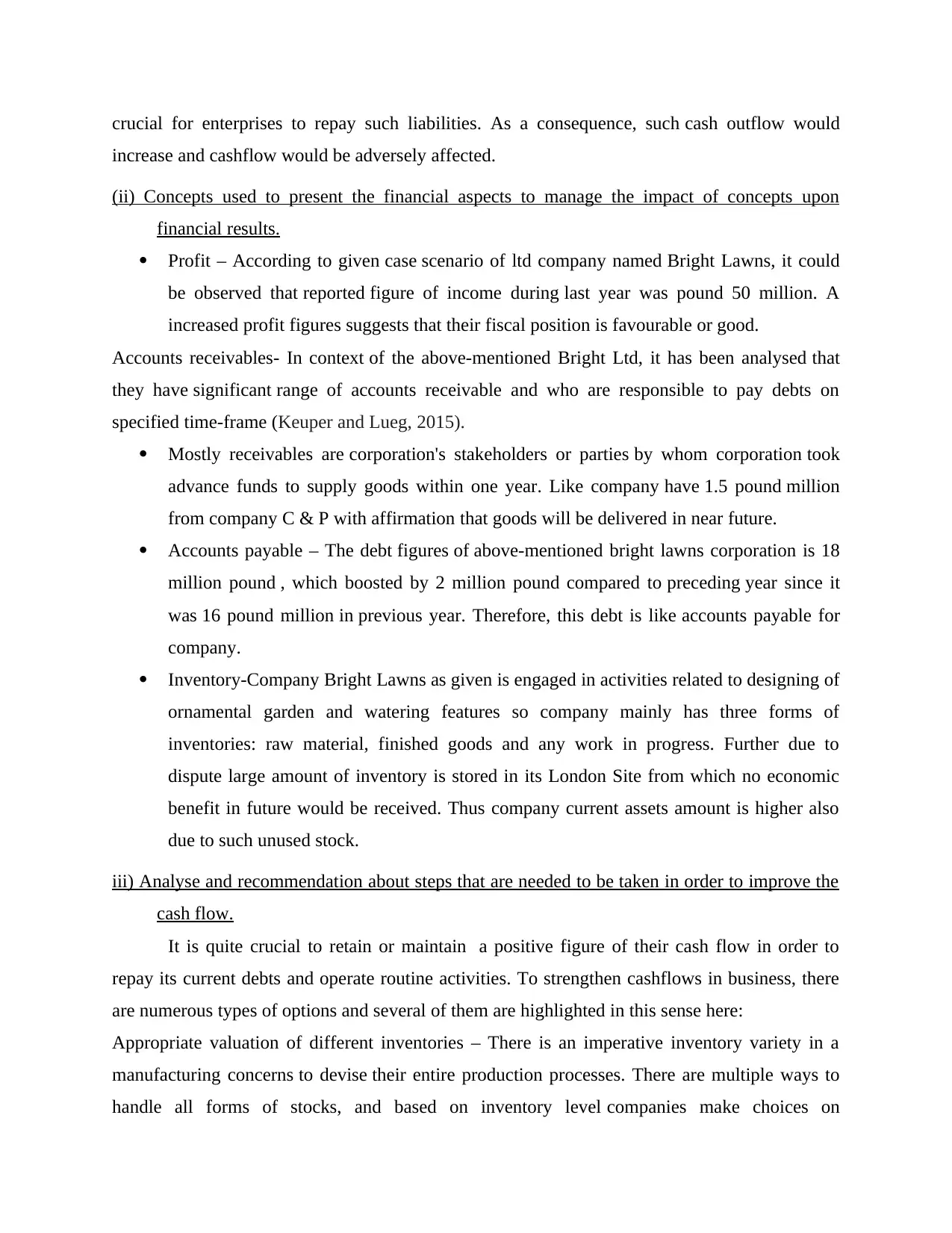
crucial for enterprises to repay such liabilities. As a consequence, such cash outflow would
increase and cashflow would be adversely affected.
(ii) Concepts used to present the financial aspects to manage the impact of concepts upon
financial results.
Profit – According to given case scenario of ltd company named Bright Lawns, it could
be observed that reported figure of income during last year was pound 50 million. A
increased profit figures suggests that their fiscal position is favourable or good.
Accounts receivables- In context of the above-mentioned Bright Ltd, it has been analysed that
they have significant range of accounts receivable and who are responsible to pay debts on
specified time-frame (Keuper and Lueg, 2015).
Mostly receivables are corporation's stakeholders or parties by whom corporation took
advance funds to supply goods within one year. Like company have 1.5 pound million
from company C & P with affirmation that goods will be delivered in near future.
Accounts payable – The debt figures of above-mentioned bright lawns corporation is 18
million pound , which boosted by 2 million pound compared to preceding year since it
was 16 pound million in previous year. Therefore, this debt is like accounts payable for
company.
Inventory-Company Bright Lawns as given is engaged in activities related to designing of
ornamental garden and watering features so company mainly has three forms of
inventories: raw material, finished goods and any work in progress. Further due to
dispute large amount of inventory is stored in its London Site from which no economic
benefit in future would be received. Thus company current assets amount is higher also
due to such unused stock.
iii) Analyse and recommendation about steps that are needed to be taken in order to improve the
cash flow.
It is quite crucial to retain or maintain a positive figure of their cash flow in order to
repay its current debts and operate routine activities. To strengthen cashflows in business, there
are numerous types of options and several of them are highlighted in this sense here:
Appropriate valuation of different inventories – There is an imperative inventory variety in a
manufacturing concerns to devise their entire production processes. There are multiple ways to
handle all forms of stocks, and based on inventory level companies make choices on
increase and cashflow would be adversely affected.
(ii) Concepts used to present the financial aspects to manage the impact of concepts upon
financial results.
Profit – According to given case scenario of ltd company named Bright Lawns, it could
be observed that reported figure of income during last year was pound 50 million. A
increased profit figures suggests that their fiscal position is favourable or good.
Accounts receivables- In context of the above-mentioned Bright Ltd, it has been analysed that
they have significant range of accounts receivable and who are responsible to pay debts on
specified time-frame (Keuper and Lueg, 2015).
Mostly receivables are corporation's stakeholders or parties by whom corporation took
advance funds to supply goods within one year. Like company have 1.5 pound million
from company C & P with affirmation that goods will be delivered in near future.
Accounts payable – The debt figures of above-mentioned bright lawns corporation is 18
million pound , which boosted by 2 million pound compared to preceding year since it
was 16 pound million in previous year. Therefore, this debt is like accounts payable for
company.
Inventory-Company Bright Lawns as given is engaged in activities related to designing of
ornamental garden and watering features so company mainly has three forms of
inventories: raw material, finished goods and any work in progress. Further due to
dispute large amount of inventory is stored in its London Site from which no economic
benefit in future would be received. Thus company current assets amount is higher also
due to such unused stock.
iii) Analyse and recommendation about steps that are needed to be taken in order to improve the
cash flow.
It is quite crucial to retain or maintain a positive figure of their cash flow in order to
repay its current debts and operate routine activities. To strengthen cashflows in business, there
are numerous types of options and several of them are highlighted in this sense here:
Appropriate valuation of different inventories – There is an imperative inventory variety in a
manufacturing concerns to devise their entire production processes. There are multiple ways to
handle all forms of stocks, and based on inventory level companies make choices on
⊘ This is a preview!⊘
Do you want full access?
Subscribe today to unlock all pages.

Trusted by 1+ million students worldwide
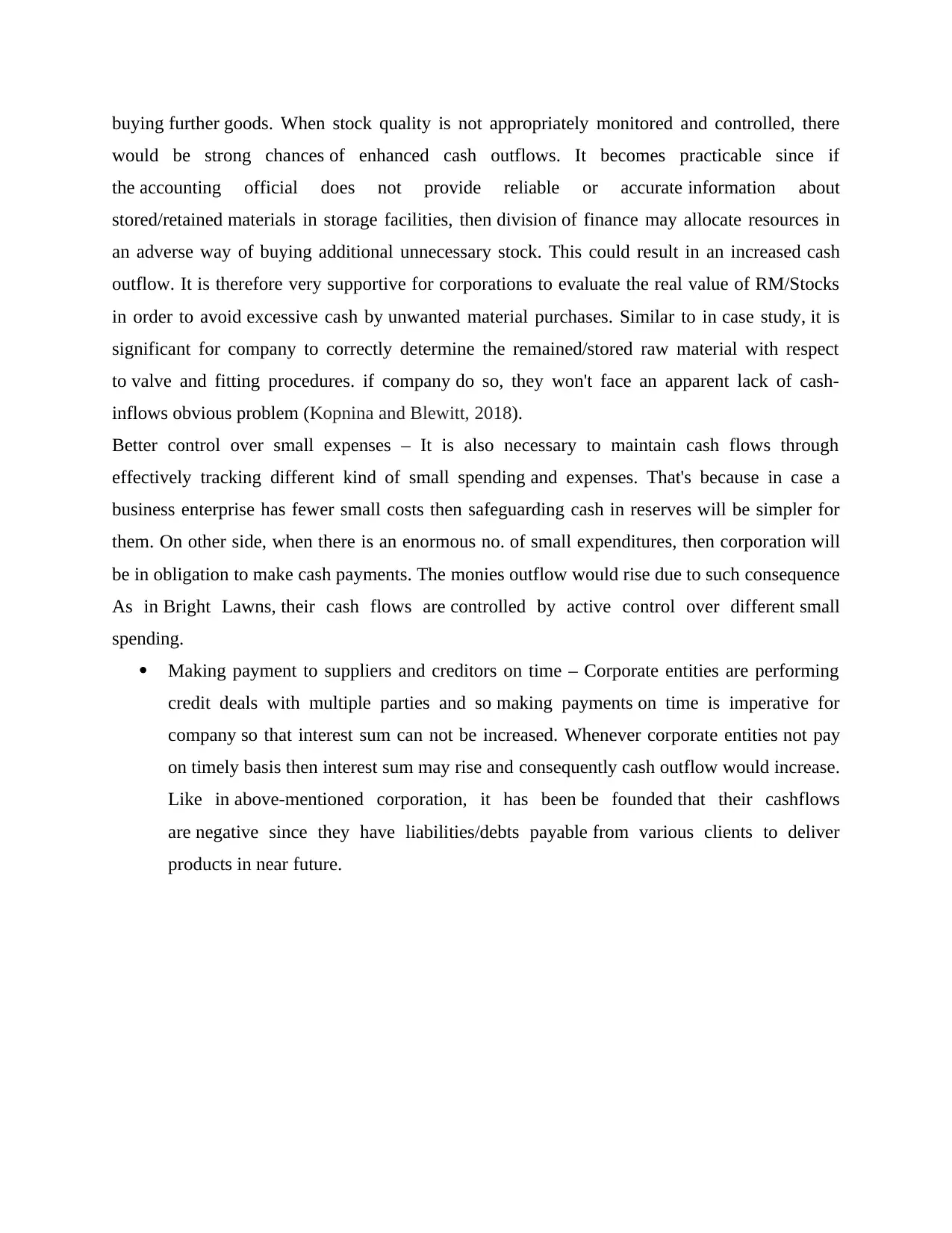
buying further goods. When stock quality is not appropriately monitored and controlled, there
would be strong chances of enhanced cash outflows. It becomes practicable since if
the accounting official does not provide reliable or accurate information about
stored/retained materials in storage facilities, then division of finance may allocate resources in
an adverse way of buying additional unnecessary stock. This could result in an increased cash
outflow. It is therefore very supportive for corporations to evaluate the real value of RM/Stocks
in order to avoid excessive cash by unwanted material purchases. Similar to in case study, it is
significant for company to correctly determine the remained/stored raw material with respect
to valve and fitting procedures. if company do so, they won't face an apparent lack of cash-
inflows obvious problem (Kopnina and Blewitt, 2018).
Better control over small expenses – It is also necessary to maintain cash flows through
effectively tracking different kind of small spending and expenses. That's because in case a
business enterprise has fewer small costs then safeguarding cash in reserves will be simpler for
them. On other side, when there is an enormous no. of small expenditures, then corporation will
be in obligation to make cash payments. The monies outflow would rise due to such consequence
As in Bright Lawns, their cash flows are controlled by active control over different small
spending.
Making payment to suppliers and creditors on time – Corporate entities are performing
credit deals with multiple parties and so making payments on time is imperative for
company so that interest sum can not be increased. Whenever corporate entities not pay
on timely basis then interest sum may rise and consequently cash outflow would increase.
Like in above-mentioned corporation, it has been be founded that their cashflows
are negative since they have liabilities/debts payable from various clients to deliver
products in near future.
would be strong chances of enhanced cash outflows. It becomes practicable since if
the accounting official does not provide reliable or accurate information about
stored/retained materials in storage facilities, then division of finance may allocate resources in
an adverse way of buying additional unnecessary stock. This could result in an increased cash
outflow. It is therefore very supportive for corporations to evaluate the real value of RM/Stocks
in order to avoid excessive cash by unwanted material purchases. Similar to in case study, it is
significant for company to correctly determine the remained/stored raw material with respect
to valve and fitting procedures. if company do so, they won't face an apparent lack of cash-
inflows obvious problem (Kopnina and Blewitt, 2018).
Better control over small expenses – It is also necessary to maintain cash flows through
effectively tracking different kind of small spending and expenses. That's because in case a
business enterprise has fewer small costs then safeguarding cash in reserves will be simpler for
them. On other side, when there is an enormous no. of small expenditures, then corporation will
be in obligation to make cash payments. The monies outflow would rise due to such consequence
As in Bright Lawns, their cash flows are controlled by active control over different small
spending.
Making payment to suppliers and creditors on time – Corporate entities are performing
credit deals with multiple parties and so making payments on time is imperative for
company so that interest sum can not be increased. Whenever corporate entities not pay
on timely basis then interest sum may rise and consequently cash outflow would increase.
Like in above-mentioned corporation, it has been be founded that their cashflows
are negative since they have liabilities/debts payable from various clients to deliver
products in near future.
Paraphrase This Document
Need a fresh take? Get an instant paraphrase of this document with our AI Paraphraser

PART 2
EXECUTIVE SUMMARY
The second section of study, summarizes two conventional and alternative approaches
related to budgeting. The objective of this study part is to provide explanation about information
on distinct varieties of budgets as well as logical analysis of such approaches to business's
budgeting. This part also contains explanation about use of different budgets in a business
enterprise.
(I) Importance of budgets and different methods of traditional budgeting.
Budget – Just those corporate entities could survive successfully in current dynamic economic
environment which are handle fiscal resources appropriately. There's only single way of
regulating a commercial entities' expenses and income, is budgeting or budget preparation. The
word budget could be interpreted as a prediction of business's income and all major expenditure.
Mostly business entities develop long-term business budgets. Accounting
personnel plans budgets so it is crucial for them to reliably foresee revenues and expenditures
Below presented are some key roles of different budgets as follows:
Advantageous in Effective organisational planning –That's crucial for corporations to
improve planning and scheduling of all major types of resources for optimal utilization. Budgets
plays a vital role in such area as budget makers can become informed about the overall funds
necessary to finance all operations with the support of budget makers. So they're planning
effectively, as with Boat world plc, their managing personnel use vital budgets data to
achieve successful planning (Minsky, 2016).
Advantageous in controlling process –A further budget benefit is that, budgets provides a
base for establishing adequate and effective contols over major business operations. This
becomes feasible since management teams can concentrate on all those tasks that lead to
excessive expenditure compared to prediction in business during specific time period. In
this context, Boat World via generated budgets, their managing staff control critical
variety of operations.
(a) Traditional budgeting approach – It could be specified as a common practice in which
budgets are formulated on simply on the basis of current operating level and past years figures. It
EXECUTIVE SUMMARY
The second section of study, summarizes two conventional and alternative approaches
related to budgeting. The objective of this study part is to provide explanation about information
on distinct varieties of budgets as well as logical analysis of such approaches to business's
budgeting. This part also contains explanation about use of different budgets in a business
enterprise.
(I) Importance of budgets and different methods of traditional budgeting.
Budget – Just those corporate entities could survive successfully in current dynamic economic
environment which are handle fiscal resources appropriately. There's only single way of
regulating a commercial entities' expenses and income, is budgeting or budget preparation. The
word budget could be interpreted as a prediction of business's income and all major expenditure.
Mostly business entities develop long-term business budgets. Accounting
personnel plans budgets so it is crucial for them to reliably foresee revenues and expenditures
Below presented are some key roles of different budgets as follows:
Advantageous in Effective organisational planning –That's crucial for corporations to
improve planning and scheduling of all major types of resources for optimal utilization. Budgets
plays a vital role in such area as budget makers can become informed about the overall funds
necessary to finance all operations with the support of budget makers. So they're planning
effectively, as with Boat world plc, their managing personnel use vital budgets data to
achieve successful planning (Minsky, 2016).
Advantageous in controlling process –A further budget benefit is that, budgets provides a
base for establishing adequate and effective contols over major business operations. This
becomes feasible since management teams can concentrate on all those tasks that lead to
excessive expenditure compared to prediction in business during specific time period. In
this context, Boat World via generated budgets, their managing staff control critical
variety of operations.
(a) Traditional budgeting approach – It could be specified as a common practice in which
budgets are formulated on simply on the basis of current operating level and past years figures. It
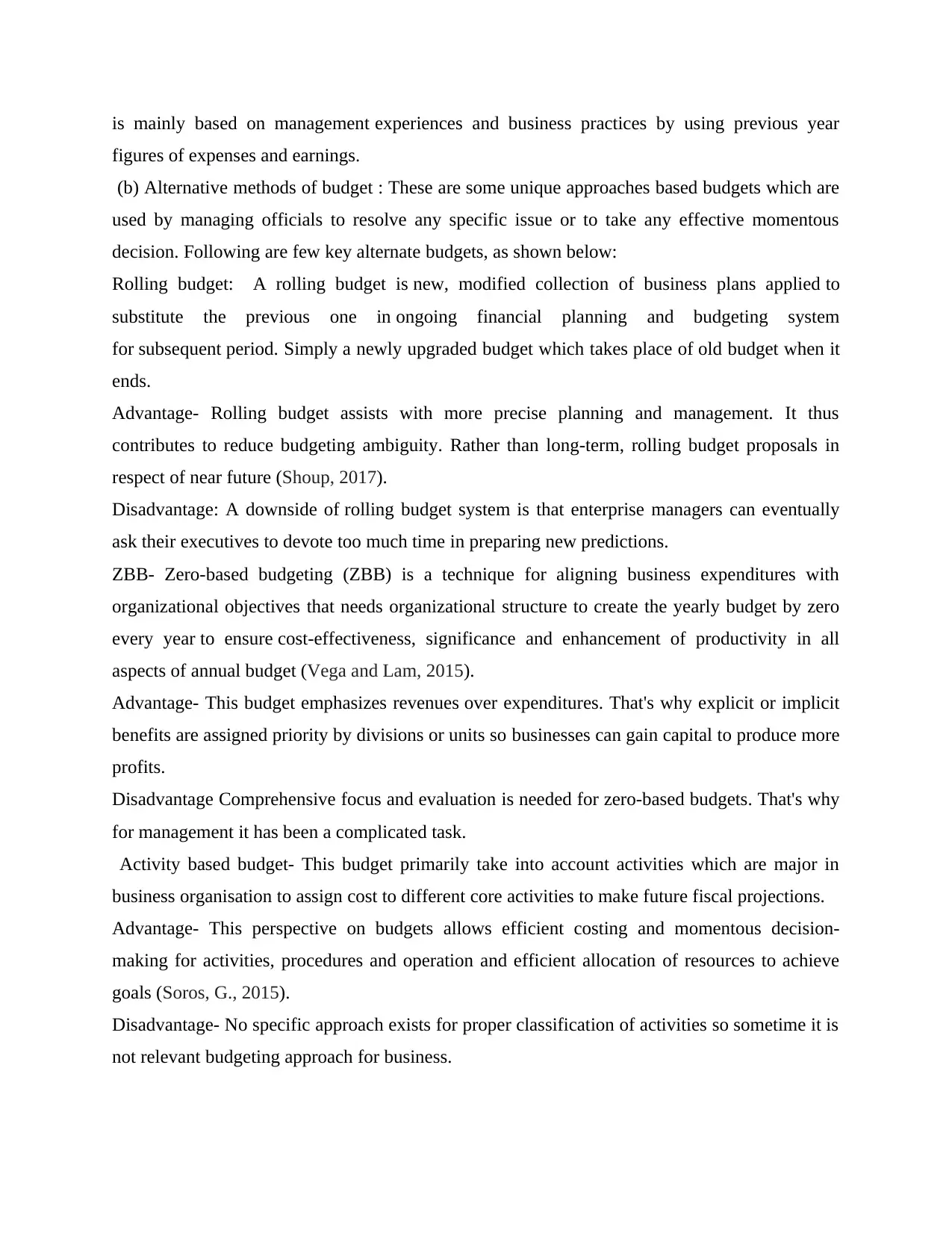
is mainly based on management experiences and business practices by using previous year
figures of expenses and earnings.
(b) Alternative methods of budget : These are some unique approaches based budgets which are
used by managing officials to resolve any specific issue or to take any effective momentous
decision. Following are few key alternate budgets, as shown below:
Rolling budget: A rolling budget is new, modified collection of business plans applied to
substitute the previous one in ongoing financial planning and budgeting system
for subsequent period. Simply a newly upgraded budget which takes place of old budget when it
ends.
Advantage- Rolling budget assists with more precise planning and management. It thus
contributes to reduce budgeting ambiguity. Rather than long-term, rolling budget proposals in
respect of near future (Shoup, 2017).
Disadvantage: A downside of rolling budget system is that enterprise managers can eventually
ask their executives to devote too much time in preparing new predictions.
ZBB- Zero-based budgeting (ZBB) is a technique for aligning business expenditures with
organizational objectives that needs organizational structure to create the yearly budget by zero
every year to ensure cost-effectiveness, significance and enhancement of productivity in all
aspects of annual budget (Vega and Lam, 2015).
Advantage- This budget emphasizes revenues over expenditures. That's why explicit or implicit
benefits are assigned priority by divisions or units so businesses can gain capital to produce more
profits.
Disadvantage Comprehensive focus and evaluation is needed for zero-based budgets. That's why
for management it has been a complicated task.
Activity based budget- This budget primarily take into account activities which are major in
business organisation to assign cost to different core activities to make future fiscal projections.
Advantage- This perspective on budgets allows efficient costing and momentous decision-
making for activities, procedures and operation and efficient allocation of resources to achieve
goals (Soros, G., 2015).
Disadvantage- No specific approach exists for proper classification of activities so sometime it is
not relevant budgeting approach for business.
figures of expenses and earnings.
(b) Alternative methods of budget : These are some unique approaches based budgets which are
used by managing officials to resolve any specific issue or to take any effective momentous
decision. Following are few key alternate budgets, as shown below:
Rolling budget: A rolling budget is new, modified collection of business plans applied to
substitute the previous one in ongoing financial planning and budgeting system
for subsequent period. Simply a newly upgraded budget which takes place of old budget when it
ends.
Advantage- Rolling budget assists with more precise planning and management. It thus
contributes to reduce budgeting ambiguity. Rather than long-term, rolling budget proposals in
respect of near future (Shoup, 2017).
Disadvantage: A downside of rolling budget system is that enterprise managers can eventually
ask their executives to devote too much time in preparing new predictions.
ZBB- Zero-based budgeting (ZBB) is a technique for aligning business expenditures with
organizational objectives that needs organizational structure to create the yearly budget by zero
every year to ensure cost-effectiveness, significance and enhancement of productivity in all
aspects of annual budget (Vega and Lam, 2015).
Advantage- This budget emphasizes revenues over expenditures. That's why explicit or implicit
benefits are assigned priority by divisions or units so businesses can gain capital to produce more
profits.
Disadvantage Comprehensive focus and evaluation is needed for zero-based budgets. That's why
for management it has been a complicated task.
Activity based budget- This budget primarily take into account activities which are major in
business organisation to assign cost to different core activities to make future fiscal projections.
Advantage- This perspective on budgets allows efficient costing and momentous decision-
making for activities, procedures and operation and efficient allocation of resources to achieve
goals (Soros, G., 2015).
Disadvantage- No specific approach exists for proper classification of activities so sometime it is
not relevant budgeting approach for business.
⊘ This is a preview!⊘
Do you want full access?
Subscribe today to unlock all pages.

Trusted by 1+ million students worldwide

(ii) Implementation of budgets to forecast cost for business.
It is essential for companies due to their crucial role in handling fiscal components
of budget techniques listed above. All methods could be beneficial in case of above-mentioned
corporation for better cost control.
Traditional budgeting approach: It is simpler and traditional approach so for accountants it is
easy to prepare and forecast figures in financial budget. In respective company, this budget is
crucial for entire decision making process. Also it provide a clear future path for business.
Company can use this budget in effectively usage of organisational resources. A traditional
budget contributes in making of decisions. Since it is quicker to find out about concerns
with budget, company can choose to change any operation. Company could cut down on costs of
doing business and find excessive if company surpass their budget expenditures (Sodeyfi, 2016).
Alternative method of budgeting:
Rolling budget- As above stated that it works on the basis of last years' budgets. Hence
for new business branches of above Boat world plc, this budget can not be suitable
because of not having any past years' budget.
ZBB- To handle the costs correctly, it can also be profitable for a corporation. That's
because most operations are justified within this budget which can be useful for new
venture of respective company.
Activity based costing budget is beneficial for corporations to provide comprehensive
cost information. It could be advantageous for an adequate cash management
in Netherlands and Germany for fresh divisions.
(iii) Analysing whether a traditional or alternative budgetary system is appropriate to all or any
parts of the business in its planned future form.
It is quite hard to criticize a specific budgetary approach either conventional/traditional or
alternative budgeting structures for businesses. The following evaluation is performed in
such way, as discussed below:
Traditional budgetary approach- This budget methodology supports existing businesses and not
new businesses. Company now planning to launch more sites, so this method of budget can not
work during starting phase. Corporation can adopt this method after some years of development,
as budgeted operations would happen in previous years.
Alternative budgetary approach-
It is essential for companies due to their crucial role in handling fiscal components
of budget techniques listed above. All methods could be beneficial in case of above-mentioned
corporation for better cost control.
Traditional budgeting approach: It is simpler and traditional approach so for accountants it is
easy to prepare and forecast figures in financial budget. In respective company, this budget is
crucial for entire decision making process. Also it provide a clear future path for business.
Company can use this budget in effectively usage of organisational resources. A traditional
budget contributes in making of decisions. Since it is quicker to find out about concerns
with budget, company can choose to change any operation. Company could cut down on costs of
doing business and find excessive if company surpass their budget expenditures (Sodeyfi, 2016).
Alternative method of budgeting:
Rolling budget- As above stated that it works on the basis of last years' budgets. Hence
for new business branches of above Boat world plc, this budget can not be suitable
because of not having any past years' budget.
ZBB- To handle the costs correctly, it can also be profitable for a corporation. That's
because most operations are justified within this budget which can be useful for new
venture of respective company.
Activity based costing budget is beneficial for corporations to provide comprehensive
cost information. It could be advantageous for an adequate cash management
in Netherlands and Germany for fresh divisions.
(iii) Analysing whether a traditional or alternative budgetary system is appropriate to all or any
parts of the business in its planned future form.
It is quite hard to criticize a specific budgetary approach either conventional/traditional or
alternative budgeting structures for businesses. The following evaluation is performed in
such way, as discussed below:
Traditional budgetary approach- This budget methodology supports existing businesses and not
new businesses. Company now planning to launch more sites, so this method of budget can not
work during starting phase. Corporation can adopt this method after some years of development,
as budgeted operations would happen in previous years.
Alternative budgetary approach-
Paraphrase This Document
Need a fresh take? Get an instant paraphrase of this document with our AI Paraphraser

Rolling budget- It has similar structure and features as
of conventional/traditional budgeting. As a result of not having budgeting operations in
previous years, the plan can't be introduced in new units of company Boat World plc.
ZBB- In beginning of several years, it might be appropriate for respective corporation.
That's because every economic activity is justified and therefore can benefit from
such budget.
ABB- For new units of respective enterprise this budget could be used too. That so
companies can monitor their operating costs and operations by means of activities
specified for this budget (Van Zon, 2016).
CONCLUSION
On the basis of above project report it has been articulated that finance is the key aspect
for business entities. Managing finance in business is crucial task for which mostly organisations
relies on budgets. Different budgets allow managing personnel to take effective business
decisions.
of conventional/traditional budgeting. As a result of not having budgeting operations in
previous years, the plan can't be introduced in new units of company Boat World plc.
ZBB- In beginning of several years, it might be appropriate for respective corporation.
That's because every economic activity is justified and therefore can benefit from
such budget.
ABB- For new units of respective enterprise this budget could be used too. That so
companies can monitor their operating costs and operations by means of activities
specified for this budget (Van Zon, 2016).
CONCLUSION
On the basis of above project report it has been articulated that finance is the key aspect
for business entities. Managing finance in business is crucial task for which mostly organisations
relies on budgets. Different budgets allow managing personnel to take effective business
decisions.
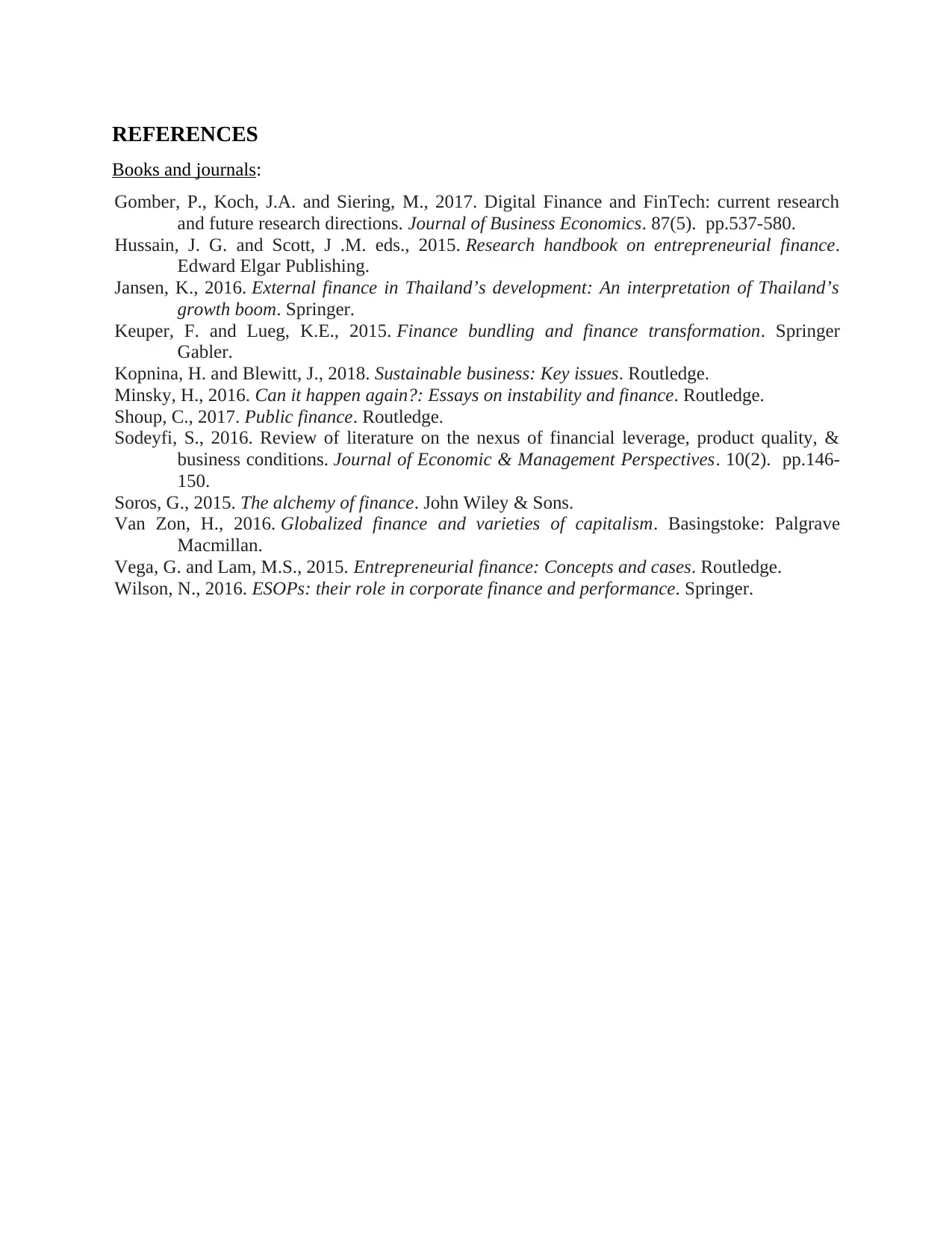
REFERENCES
Books and journals:
Gomber, P., Koch, J.A. and Siering, M., 2017. Digital Finance and FinTech: current research
and future research directions. Journal of Business Economics. 87(5). pp.537-580.
Hussain, J. G. and Scott, J .M. eds., 2015. Research handbook on entrepreneurial finance.
Edward Elgar Publishing.
Jansen, K., 2016. External finance in Thailand’s development: An interpretation of Thailand’s
growth boom. Springer.
Keuper, F. and Lueg, K.E., 2015. Finance bundling and finance transformation. Springer
Gabler.
Kopnina, H. and Blewitt, J., 2018. Sustainable business: Key issues. Routledge.
Minsky, H., 2016. Can it happen again?: Essays on instability and finance. Routledge.
Shoup, C., 2017. Public finance. Routledge.
Sodeyfi, S., 2016. Review of literature on the nexus of financial leverage, product quality, &
business conditions. Journal of Economic & Management Perspectives. 10(2). pp.146-
150.
Soros, G., 2015. The alchemy of finance. John Wiley & Sons.
Van Zon, H., 2016. Globalized finance and varieties of capitalism. Basingstoke: Palgrave
Macmillan.
Vega, G. and Lam, M.S., 2015. Entrepreneurial finance: Concepts and cases. Routledge.
Wilson, N., 2016. ESOPs: their role in corporate finance and performance. Springer.
Books and journals:
Gomber, P., Koch, J.A. and Siering, M., 2017. Digital Finance and FinTech: current research
and future research directions. Journal of Business Economics. 87(5). pp.537-580.
Hussain, J. G. and Scott, J .M. eds., 2015. Research handbook on entrepreneurial finance.
Edward Elgar Publishing.
Jansen, K., 2016. External finance in Thailand’s development: An interpretation of Thailand’s
growth boom. Springer.
Keuper, F. and Lueg, K.E., 2015. Finance bundling and finance transformation. Springer
Gabler.
Kopnina, H. and Blewitt, J., 2018. Sustainable business: Key issues. Routledge.
Minsky, H., 2016. Can it happen again?: Essays on instability and finance. Routledge.
Shoup, C., 2017. Public finance. Routledge.
Sodeyfi, S., 2016. Review of literature on the nexus of financial leverage, product quality, &
business conditions. Journal of Economic & Management Perspectives. 10(2). pp.146-
150.
Soros, G., 2015. The alchemy of finance. John Wiley & Sons.
Van Zon, H., 2016. Globalized finance and varieties of capitalism. Basingstoke: Palgrave
Macmillan.
Vega, G. and Lam, M.S., 2015. Entrepreneurial finance: Concepts and cases. Routledge.
Wilson, N., 2016. ESOPs: their role in corporate finance and performance. Springer.
⊘ This is a preview!⊘
Do you want full access?
Subscribe today to unlock all pages.

Trusted by 1+ million students worldwide
1 out of 39
Related Documents
Your All-in-One AI-Powered Toolkit for Academic Success.
+13062052269
info@desklib.com
Available 24*7 on WhatsApp / Email
![[object Object]](/_next/static/media/star-bottom.7253800d.svg)
Unlock your academic potential
Copyright © 2020–2025 A2Z Services. All Rights Reserved. Developed and managed by ZUCOL.





